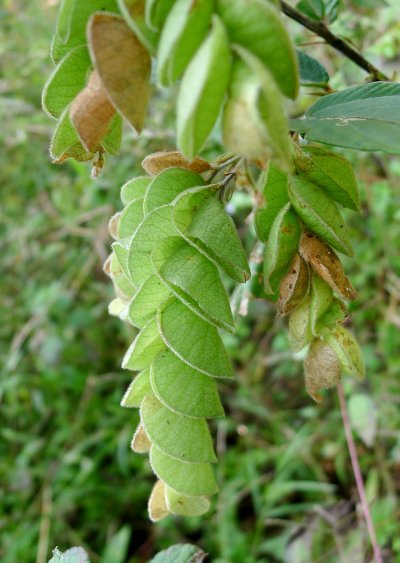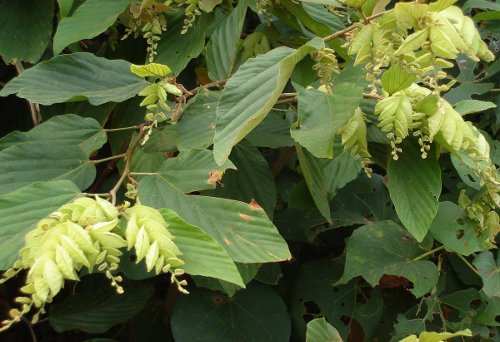Luck plant
 Common names: luck plant, wild hops, Qiu sui qian jin ba, Sainfoin du bengale
Common names: luck plant, wild hops, Qiu sui qian jin ba, Sainfoin du bengale
Scientific name: Flemingia strobilifera
Climate: Temperate
Plant description: It is a perennial shrub, measuring between 0.3 and 3 m in height. Its ribbed, hairy branches are thickly gray to a dull brown.
The leaves are oval with veins on both sides and wavy margins.
Flowers from February to August and the fruit ripens from August to November.
It has small white pea-shaped flowers surrounded by a pair of kidney-shaped leaflets in 2 rows along the bunch that become thin and papery when dried.
The small cylindrical pods release their tiny black and red seeds through an explosive opening.
It is native to a wide area of South and Southeast Asia, from Pakistan in the west to eastern China and the Japanese Ryuku Islands in the northeast, and south to Irian Jaya (Indonesia) and Timor-Leste.
It has been introduced in some tropical regions, especially in Central America, the Caribbean, the islands of the Indian Ocean and the Pacific.
Cultivation: It is a prolific seed producer and can grow back after cutting. It can quickly form thickets and then dense patches that outgrow native vegetation, especially in disturbed areas. It also encroaches on agricultural land.
If the seeds are dry, to speed up and improve germination, they are put in hot water and then soaked for 12 to 24 hours in warm water before sowing. After this they must have absorbed moisture and be swollen; if not, the seed cap is carefully notched (being careful not to damage the embryo) and allowed to soak for an additional 12 hours before sowing.
Species in this genus generally do well in sunny or partially shady locations as long as the soil is well-drained.
It grows well on mountain slopes at elevations of 200 to 1,600 meters, abandoned grasslands, and other disturbed areas.
 Uses: Ripe fruits (peas) are eaten fresh.
Uses: Ripe fruits (peas) are eaten fresh.
Ornamental and multiple medicinal uses.
A decoction or infusion of the leaves and flowers is used in the treatment of tuberculosis. The leaves are used both externally and internally as a children's vermifuge.
The leaves can be cooked to make a bath after childbirth. They are also used as a treatment for rheumatism.
One seed chewed per month works as a female contraceptive.
The root is used to treat indigestion, fevers, epilepsy, and hysteria, to induce sleep and relieve pain. If a sufficient dose is taken, the roots can induce deep sleep even if the person is experiencing great pain. It has no adverse effects.
The dried leaves are used to fill pillows and cushions.
References:
Fern, K. (2019, June 13). Flemingia strobilifera. Useful Tropical Plants. http://tropical.theferns.info/viewtropical.php?id=Flemingia+strobilifera
Forest Research Institute Dehradun, & Kumar, A. (2014, September). DIVERSITY OF FLEMINGIA AND THEIR IMPORTANCE IN LAC CULTIVATION. Forest Research Institute Dehradun. https://www.researchgate.net/publication/313024942_DIVERSITY_OF_FLEMINGIA_AND_THEIR_IMPORTANCE_IN_LAC_CULTIVATION
Pasiecznik, N., & Sandoval, J. (n.d.). Flemingia strobilifera (wild hops). CABI. Retrieved August 14, 2020, from https://www.cabi.org/isc/datasheet/24229
Wikipedia contributors. (2019, December 27). Flemingia strobilifera. Wikipedia. https://en.wikipedia.org/wiki/Flemingia_strobilifera
En español: Camaron
